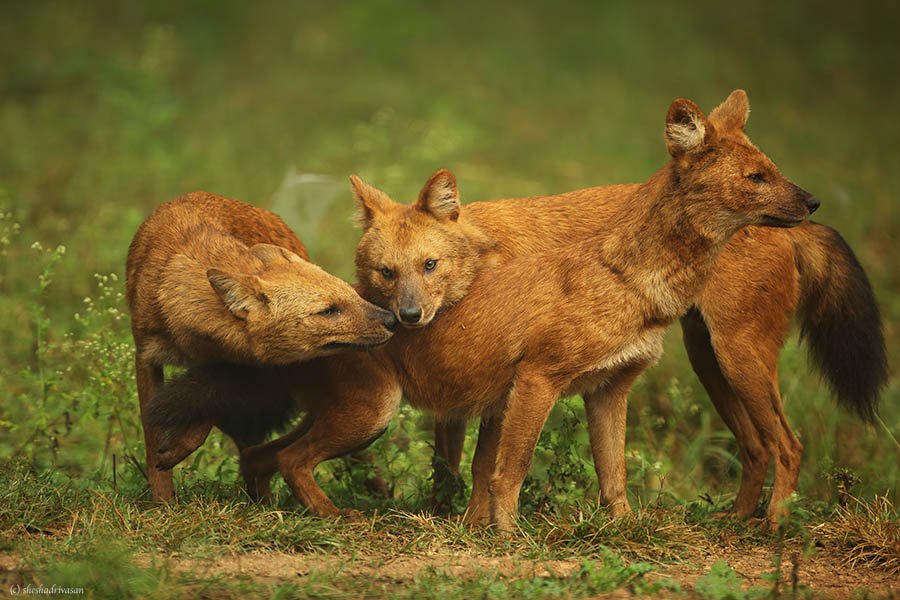The Underdog of the Deccan

The Red Whistling Dog of the Deccan, was popularized by Rudyard Kipling in one of his Jungle Book stories, as the ferocious red dog, packs of which cut through anything in their way and tire down the animal till the very earth’s end! Although little-known, dholes have a plethora of names: the Asiatic wild dog, the red wolf, Ussuri, and the whistling dogs among them, along with some 40 or so indigenous names. However, the origins of the name ‘dhole’ remain obscure.
Dhole are charismatic and social canids and one of the most exciting predators to encounter in India’s national parks. It is a fact that fewer visitors on an Indian wildlife tour will see wild dogs compared to tigers, so sightings should be viewed as lucky and incredibly exciting. Dholes are currently distributed across forests of South and Southeast Asia. Dholes inhabit some of the most threatened, degraded and disconnected forest landscapes on the planet. Their numbers have dwindled in many parts of their distribution range. Most dhole populations are restricted to protected forest habitats, but also occur in reserve forests and production agroforests (like tea and coffee plantations). Although dholes are found in forests outside protected reserves, they seem to avoid areas with high human activity. Some of the largest packs of wild dogs can be seen in Bandipur and Nagaerhole tiger sanctuaries; both located in Karnataka state in southern India. Bandhavgarh, Kanha, Pench, Tadoba and most recently in Nagzira also boast of these wonderful creatures. In central India the packs of wild dogs can still migrate from park to park via small but intact forest corridors, which can lead to the loss of packs in one of the sanctuaries, when they move into another, hence they may have smaller packs residing there. Dholes in South India seem to have bigger packs.
Dholes have large, rounded ears, hooded eyes with amber-colored irises, and a shorter muzzle than most canids. The dog also has a broad, domed skull with an enlarged forehead and upper jawbones that produce a slightly concaved face. The Indian wild dog typically weighs 26 to 44 pounds, and its black-tipped tail is between 16 and 18 inches long. These creatures are about 35 inches long and 20 inches tall from the shoulder, sporting rust-colored coats with white undersides and chests. The Dhole often also has an area of darker fur on its back. In general, the dholes living in the northern regions of the Dhole’s range have longer and lighter fur than do the dholes living in the southern regions. These are known to be a highly social and cooperative animal. There are generally more males than females in a pack, and there is usually only one breeding female per pack. The alpha pair are dominant but not excessively aggressive towards the beta pack members. Packs inhabit a territory that ranges from 40 to 84 square kilometres, depending on the availability of food and water and the presence or absence of pups. Packs with pups tend to occupy smaller territories. Scent marking is used to delineate territories. They have some extraordinary vocalizations that warn members of the pack of danger. Its repetitive whistles are so distinct that they can identify individual members of the pack. There is a strict social hierarchy within the pack, so fighting and aggression rarely occur. The Dhole reaches sexual maturity at about one year of age. The mating season takes place from September to March. After a gestation period of 60 to 63 days, each female dhole gives birth to typically three to four but occasionally up to ten pups. Pups are soot-coloured at birth, but take on their adult colour by the time they reach three months of age. Births take place in a den. Dens may be shared with other breeding females. Pack members help to take care of mothers and their litters, bringing them food (in the form of regurgitated meat) and guarding the dens. The pups begin to explore the area outside the den at ten weeks of age, and start hunting with the pack when they are seven months old. Pack members make sure pups get their fair share of food at pack kills. Pups play and fight with each other. Dominance orders are usually established among a pack’s pups by the time they begin hunting with the pack. When pups reach maturity, some stay with their parents’ pack and others leave. The Dhole’s life span is approximately ten years.
Hunting is one of the most unique to these creatures. They hunt during the day, which means that several of their hunts have been witnessed by people who tagged the beasts as bloody and savage killers. Dhole hunting parties are known to employ a variety of tactics to bring down their prey, including splitting into small scouting groups. When successful, dholes don’t suffocate prey like the cats .While a few chase the animal, others break away in a flanking movement, to run ahead of their quarry and ambush it as it dashes past them, They emit a series of yelps in a very high pitch, resembling the whistling cry of a bird rather than a dog. The quarry is brought to earth after being attacked by these flankers, which bite out its eyes, disembowel it, hamstring or emasculate it, in their efforts to bring it down. Once they attack an animal they never relax, hanging on to any part of the quarry and often devouring it alive. They are said to attack the eyes first and the anus next and with their paws remove the entrails. They run at a tireless trot and nothing is safe from them, even tigers, leopards, bison and buffalos are attacked. Much of the fear of dholes comes from the way they kill their prey. They do not possess the strength of big cats. Dholes have been known to attack tigers, when the occasion demanded, and the striped cat normally stays clear of them. Leopards however are their sworn enemies as they are known to attack dholes. There have been reports from Central India’s Bandhavgarh of a pack of dholes stealing kills from a tiger and even killing the big cat.
Sadly, this graceful canine has been much maligned for the better part of the last century. For the sport hunters of British India, dholes were not valuable as trophies, nor did they serve as good ‘game’ species. Large packs of dholes were often observed hunting herbivores like deer and gaur, disemboweling and eating their quarry alive. This feeding tactic of the dhole, whose jaw strength is not as powerful as the tiger or the leopard to deliver a killing bite at the throat, furthered its negative reputation. Dholes were treated as ‘vermin’ and bounty-hunted in India until they were brought under protection in 1972 with the Wild Life Protection Act.
The recent IUCN Red List assessment suggests that there may be 1,000–2,000 adult, mature dholes left in the wild. This number is yet a vague ‘guesstimate’ since there are no reliable methods to accurately estimate their population sizes. Dholes once inhabited numerous Asian countries from Russia to South Korea. Now found only in the southern part of India, mostly in the Western Ghats. When people think of endangered animals, it’s usually the charismatic megafauna that first comes to mind. People instantly relate it to the Elusive leopard or the Majestic tiger . We tend to think of massive herbivores like the Elephant or the Rhinos, we even relate to marine life like the sharks and whales, Or many of us envision a cute animal . Rarely does our mind wander towards this underdog of the Indian forest .Animals like the dhole, which don’t wow us with their size or touch our hearts with their cuteness, rarely receive the same amount of attention. Research says Tigers and leopards are more resilient than dholes. Leopards survive and thrive in a wide range of habitats. Tigers do need forest cover but they are also able to disperse long distances through mixed landscapes with forests and human-use areas Dholes are perhaps a lot more sensitive to forest cover and therefore require more nuanced approaches for population recovery. Globally, dholes have disappeared from approximately 82 percent of their former range. The Western Ghats perhaps supports the largest population in the world and is therefore a critical conservation landscape for the species.
For long, the scientific community had to depend on anecdotal tales on dholes mainly from British officers in colonial India . Some path breaking researchers are now throwing light on these intricate species. The study by A.J.T. Johnsingh in 1976 – 1978 in Bandipur Tiger Reserve disclosed that dholes are not bloodthirsty as portrayed; instead they are extremely social and cooperative, living in organized packs. When a pack is not hunting, the dholes are sleeping or at play, bonding socially, sharpening their hunting skills and establishing rank. Similar extraordinary work is done by Ambika Khatiwada in the Kangchenjunga Conservation Area (KCA). in Nepal. These are truly some of the Silver lining to this dwindling clan. India has set a stellar example being at the forefront of global efforts in scientific monitoring and conservation of tigers. It is time perhaps that we replicate these efforts to secure the future for dholes
